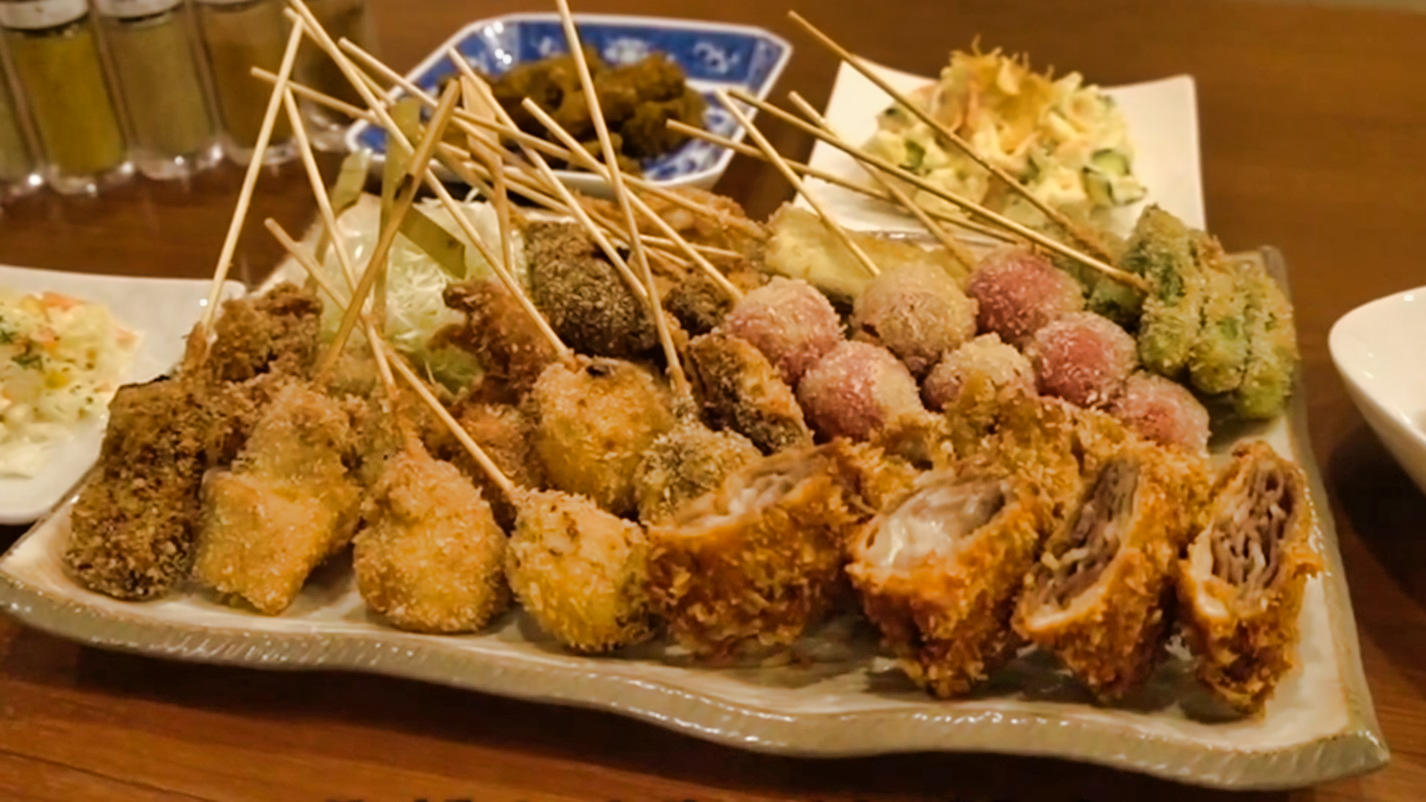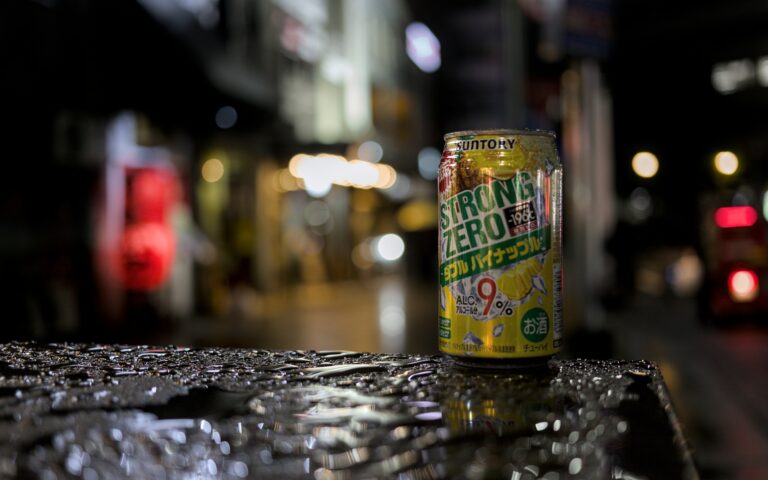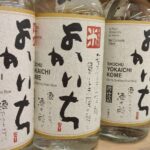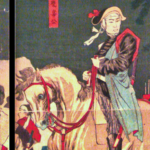- What is kushikatsu?
- The origins of kushikatsu
- Common kushikatsu ingredients
- How kushikatsu is made
- Regional twists: Kushikatsu variations across Japan
- Mind your manners: kushikatsu dining etiquette
- Where to eat: Finding great kushikatsu
- DIY kushikatsu: Because we have Japan at home
- Conclusion
- FAQ
- What exactly is kushikatsu?
- What does kushikatsu mean?
- Is kushikatsu the same as kushiage?
- Where did kushikatsu come from?
- Why is kushikatsu so popular in Osaka?
- What are common ingredients used for kushikatsu?
- What's the difference between kushikatsu batter and tempura batter?
- What if I want more sauce after my first dip?
- What is the cabbage for?
- How do I order kushikatsu?
- What do I do with the used skewers?
- Are there different styles of kushikatsu in Japan?
- Where are the best places to eat kushikatsu in Japan?
- Is it possible to make kushikatsu at home?
- Is kushikatsu healthy?
- What drinks go well with kushikatsu?
- Can vegetarians eat kushikatsu?
If you find yourself in Japan and are looking for a unique dining experience, kushikatsu is a must-try. This beloved comfort food consisting of deep fried skewered meat, vegetables, and seafood, has captured the hearts of locals and travelers alike. In this article, I’ll aim to give you the most comprehensive guide to kushikatsu possible. We’ll be covering its origins, ingredients, preparation, regional variations, dining etiquette, and even how to make it at home.
What is kushikatsu?
Kushikatsu as her first proper meal~
— Tori Thaiga🐯🍳✧Foodie VtuberꔫMOE!Liveꔫ (@ToriThaiga) May 25, 2024
Deep fried stuff is the best 😤#ThaigaAbroad pic.twitter.com/wuk2b9iqm2
Kushikatsu, also known as kushiage, is a Japanese dish featuring bite-sized pieces of meat, seafood, and vegetables skewered on bamboo sticks, coated in batter, and deep fried to golden perfection. The name “kushikatsu” comes from two Japanese words: “kushi,” meaning skewer, and “katsu,” referring to a deep fried cutlet. The result is a crispy, savory skewer that’s both satisfying and addictive.
Why is kushikatsu a beloved Japanese comfort food?
Kushikatsu holds a special place in Japanese cuisine due to its affordability and accessibility. Traditionally a cheap and filling meal, it’s widely available at casual eateries, street stalls, and upscale restaurants alike (although it’s most commonly found at casual eateries). The dining experience is fun and relaxed, often enjoyed with friends over drinks. Plus, the crispy texture and rich flavors make every bite a delight.
Wanna know more? Good, let’s get into the history of kushikatsu, common ingredients, preparation techniques, regional styles, dining etiquette, the best places to enjoy it, and even a DIY recipe for making it at home for those of you that can’t afford a plane ticket.
The origins of kushikatsu
My dream reward is:
— カズヤ Tabi 🟧 $LINGO 🟠 NFTARMY (@kafya_n) December 10, 2024
I want to eat kushikatsu.
串カツ食べたい#Dreamscometrue $Lingo pic.twitter.com/AhBOvS83tI
Its birthplace: Osaka’s Shinsekai district
Kushikatsu originated around 1929 in the vibrant Shinsekai district of Osaka. This is the same area that’s known for having Billiken statues plastered everywhere starting 1912. Coincidence? Maybe… Initially, kushikatsu was created as an affordable, hearty meal for laborers in the area. Early versions mainly used simple ingredients like beef and potatoes, skewered and fried to provide a quick, calorie-packed bite. It was food for the working-class after all.
Spread and evolution
Over time, kushikatsu gained popularity throughout Osaka and eventually spread across Japan. As its fame grew, so did the variety of ingredients used. From meats and seafood to vegetables and even desserts, kushikatsu evolved into a versatile dish with something for everyone. It’s almost like a buffet of fried skewers when you think about it.
Kushikatsu today
Kushikatsu Matsuba is so nice because the kushikatsu is lined up right in front of you at eye-level
— OsakaBob_Official (@Bob_OGTB) December 9, 2024
It's the perfect style if you need a quick bite to eat. And the kushikatsu here are delicious! pic.twitter.com/Qd4kXaMwhX
What started as a humble street food has become a staple in Japanese cuisine, available everywhere from casual standing bars to specialty restaurants. Today, kushikatsu is celebrated as both a nostalgic comfort food and a classic traditional Japanese meal.
Common kushikatsu ingredients
Kushikatsu uses a wide variety of ingredients which means there’s something to suit every palate. Here are some of the most popular choices:
Meats
- Beef (Gyūniku): A classic choice for a hearty skewer.
- Pork (Butaniku): Often includes cuts like pork belly for extra juiciness.
- Chicken (Tsukune): Minced chicken, gizzards, or skin for varied textures.
- Sausage: A modern twist that’s especially popular with kids.
Seafood
- Shrimp (Ebi) and Prawns: Succulent and flavorful when fried.
- Scallops (Hotate): A tender, luxurious option.
- Fish: Varieties like horse mackerel (aji), whitings (kisu), and shishamo.
- Octopus (Tako) and squid (Ika): Chewy yet crispy delights.
Vegetables
- Onion: Sweet and juicy when fried.
- Eggplant (Nasu): Soft and creamy inside a crispy shell.
- Shiitake mushrooms: Earthy and savory.
- Lotus root (Renkon): Adds a unique crunch.
- Green peppers, bamboo shoots, asparagus, sweet potatoes: For variety, freshness, and color.
Other popular options
- Cheese: Melty and indulgent.
- Quail eggs: Small but packed with flavor.
- Mochi: A chewy, sweet-savory skewer.
Unique and modern variations
Some specialty shops break the traditional mold by offering skewers with fruits or even desserts, showcasing the endless possibilities of battered and fried skewers. Maybe not everything should be deep fried but without those guys, how would we find unusual combinations like cheese kushikatsu?
How kushikatsu is made
Luckily for you and I, kushikatsu isn’t complicated to make or explain. It’s like Italian food in the sense that it’s rather simple to make but difficult to get just right.
1. Skewering
Kushikatsu starts with bite-sized pieces of ingredients pierced onto bamboo skewers, known as “kushi.” This ensures easy eating and even cooking but more importantly, leaves you with clean hands after eating.
2. Battering
The ingredients are then coated in a batter made from flour, egg, and panko (Japanese breadcrumbs), which gives kushikatsu its signature crunch. Unlike tempura batter, kushikatsu batter tends to use an egg and flour mixture with panko for a heartier texture. Some regions add unique twists, like grated yam or white wine, to enhance the batter’s flavor and texture.
3. Deep frying
The skewers are fried in vegetable oil at an optimal temperature until they turn golden and crispy. Precision is key to achieving the perfect balance of crunch and juiciness. The exact temperature depends on whether you’re frying meat or vegetables and varies depending on the chef’s experience.
4. Sauces
Kushikatsu is typically served with a tonkatsu-style sauce, a tangy and slightly sweet dipping sauce. However, variations exist depending on the region or restaurant, with some offering sweeter sauces or miso-based options for a different flavor profile.
Regional twists: Kushikatsu variations across Japan
Osaka style
As the birthplace of kushikatsu, Osaka is known for kushikatsu as much as it’s known for okonomiyaki and takoyaki. Here, skewers often feature single ingredients, menus encourage diners to order a wide variety. The smaller skewers make it easy to sample many flavors in one sitting.
Tokyo (Kanto) style kushiage
In Tokyo and the Kanto region, kushikatsu is often called “kushiage”. Skewers may combine multiple ingredients, like pork and onion, and are sometimes seasoned with a thick brown sauce right at the table.
Nagoya style
Nagoya is famous for “Miso Katsu,” where kushikatsu is dipped in a rich, hatcho miso-based sauce. It’s often paired with “doteni,” a local beef cheek stew for a hearty meal.
Other unique offerings
Some restaurants offer creative takes like fondue-style kushikatsu or curated course menus, elevating the dining experience with premium ingredients and presentations. The omakase-style restaurants also usually balance out the oiliness of the food rather nicely with the order of the dishes they serve you.
Mind your manners: kushikatsu dining etiquette
The cardinal rule: NO DOUBLE-DIPPING!
Although many shops have switched to squeeze bottles since Covid-19, Most kushikatsu restaurants still serve the kushikatsu sauce in communal sauce containers. For hygiene reasons, double-dipping is a big no-no. Dip your skewer once, and that’s it.
Using the cabbage
Cabbage has a dual purpose. It’s served alongside kushikatsu as a palate cleanser but if you need more sauce, use a piece of cabbage to scoop it up and pour it onto your skewer instead of dipping it again.
Eating from the skewer
Don’t remove the food from the skewer, eat it directly off the stick for the full experience. It’s the best way to keep your hands clean anyway.
Disposing of used skewers
Place used skewers in the designated container on the table. In the rare event that there isn’t one, place them parallel to your plate.
Ordering and pacing
Kushikatsu is usually ordered by the skewer, so feel free to start with a few and add more as you go. Pace yourself, enjoy some drinks, and savor the food with your companions.
Where to eat: Finding great kushikatsu
Famous Kushikatsu Areas
- Shinsekai, Osaka: The birthplace of kushikatsu, brimming with iconic eateries.
- Dotonbori, Osaka: A popular tourist spot with countless kushikatsu options.
Types of establishments
- Casual standing bars and street stalls: Perfect for a quick, authentic bite the way they used to be served.
- Family-friendly restaurants: Great for a relaxed meal.
- Upscale kushikatsu restaurants: For the premium experience with the best ingredients.
Well-known kushikatsu chains
- Kushikatsu Daruma: An iconic Osaka chain known for its classic flavors.
- Yaekatsu: A Shinsekai favorite with a long history.
- Kushikatsu Tanaka: A popular chain with locations across Japan.
DIY kushikatsu: Because we have Japan at home
Sadly, we’re not all fortunate enough to visit Japan and get the authentic experience but as a culinary connoisseur, you also want to try it out right? Here’s how.
Basic ingredients and equipment needed
To make kushikatsu at home, you’ll need bamboo skewers, your choice of ingredients (meat, seafood, vegetables), flour, eggs, panko breadcrumbs, vegetable oil for frying, and a tonkatsu-style dipping sauce. A deep fryer or heavy pot and a thermometer for monitoring oil temperature are also essential but a wok will work in a pinch and use less oil because of its flared base.
Make sure you pick a handful of ingredients though, there’s a lot of cleanup afterwards so you might as well have a good meal.
Simple steps
If you need detailed instructions, refer to the video above. The following instructions assumes you’re a competent cook that doesn’t need long, drawn out instructions.
Prepare ingredients
Cut your chosen ingredients into bite-sized pieces and skewer them.
Make the batter
Mix flour, beaten eggs, and panko in separate bowls for a three-step coating process.
Fry the skewers
Heat oil to around 340-350°F (170-180°C)and fry the skewers until golden brown, about 2-3 minute
Homemade sauce
Combine Worcestershire sauce, water, soy sauce, ketchup, and a touch of sugar for a quick and basic tonkatsu-style dipping sauce. Add mirin and soy sauce for a bit of extra depth and shop authenticity.
Additional tips
- Don’t overcrowd the fryer to maintain oil temperature.
- Use fresh ingredients for the best flavor.
- Experiment with different coatings and sauces to find your favorite combination.
Conclusion
Kushikatsu is more than just fried skewers, it’s a celebration of Japanese comfort food, tradition, and creativity. Whether you’re enjoying crispy skewers in the lively streets of Osaka’s Shinsekai or trying your hand at a homemade batch, kushikatsu is a delightful and experience to share with your fellow food lover friends or loved ones. So if you find yourself in Osaka, give it a shot and explore its many varieties and regional twists, and savor the joy of this iconic Japanese meal. It’s so simple yet so unique.
FAQ
What exactly is kushikatsu?
Kushikatsu, AKA kushiage, is a Japanese dish made by skewering various ingredients like meat, seafood, and vegetables, coating them in batter and panko breadcrumbs, and then deep frying them until golden and crispy.
What does kushikatsu mean?
Is kushikatsu the same as kushiage?
Yes, the terms are often used interchangeably. “Kushiage” (串揚げ) also means “fried skewers.” Sometimes, “kushiage” might be used to refer to a slightly more high-class version or skewers from regions outside Osaka (especially in the Kanto region), but generally they refer to the same type of dish.
Where did kushikatsu come from?
Kushikatsu originated in the Shinsekai district of Osaka, Japan around 1929. It started as an affordable and filling meal for laborers.
Why is kushikatsu so popular in Osaka?
Because that’s where it was invented.
What are common ingredients used for kushikatsu?
Popular ingredients include beef, pork, chicken, shrimp, scallops, various fish, onions, eggplant, shiitake mushrooms, lotus root, cheese, and quail eggs. Some places even offer unique items like mochi or dessert skewers.
What’s the difference between kushikatsu batter and tempura batter?
Kushikatsu batter typically includes eggs with the flour and then panko (Japanese breadcrumbs) on the outside, which gives it a crispier, more substantial coating compared to tempura batter, which is usually lighter and made from flour and water.
What if I want more sauce after my first dip?
Use the cabbage to scoop the sauce onto the skewer on your plate, don’t double-dip.
What is the cabbage for?
It’s mainly to cleanse your palate but it also serves as a scoop for you to get more sauce if you didn’t get enough.
How do I order kushikatsu?
Order a couple of skewers for a nice variety with some drinks and then order more as you go.
What do I do with the used skewers?
There’s usually a container for you to put them in. If not, you cna stack them parallel to your plate.
Are there different styles of kushikatsu in Japan?
Yes, the most famous ones are the Osaka style, Tokyo (Kanto) style and the Nagoya style. The Kanto style tends to serve multiple ingredients per skewer and the Nagoya style has a miso-based sauce.
Where are the best places to eat kushikatsu in Japan?
The area around Shinsekai and Dotonbori in Osaka are famous for kushikatsu.
Is it possible to make kushikatsu at home?
Yes although it might be too much trouble for a single meal, you’ll need your desired ingredients, bamboo skewers, flour, egg, panko breadcrumbs, and oil for deep frying.
Is kushikatsu healthy?
No, they’re deep fried skewers. The furthest thing possible from healthy so enjoy it in moderation.
What drinks go well with kushikatsu?
Kushikatsu pairs wonderfully with cold beer, highballs, or sake.
Can vegetarians eat kushikatsu?
Yes, there are many vegetable kushikatsu options available (no vegan ones as the batter usually contains egg), such as onion, eggplant, shiitake mushroom, lotus root, and asparagus. If you’re concerned about meat cross-contamination however, you’re out of luck because most kushikatsu places fry everything in the same oil.








